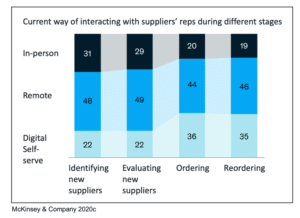Digital Customer Engagement – The „diCE-Model“
E-Commerce Institute (HS Fresenius) and ORT Medienverbund cooperate.
Corona is causing typical sales patterns to change, and companies are losing their personal proximity to their customers. Replacing traditional sales activities with new digital concepts alone is not enough. ORT (Agency Group for Sales and Marketing) and the E-Commerce Institute of the Fresenius University of Applied Sciences have set themselves the task of developing a new and scientifically tested sales model that achieves customer proximity through lasting, relevant and integrated customer engagement along the customer journey in order to ensure maximum sales success in the future.
From now on, you can follow the progress and results of the cooperation on this page.
The diCE-Model:
Successful sales in times of Corona and beyond.
Problem definition and derivation
“ (…) COVID-19 has pushed companies over the technology tipping point—and transformed business forever“ (McKinsey Company 2020a, n.p.).
Almost nothing is like it was before COVID-19. Fairs or events no longer take place, restaurant visits are illegal, face to face appointments are limited, schools are closed, offices are empty. Many people are sick, and the health-care system is reaching its capacity limits. The COVID-19 pandemic is forcing the entire population to change (Zeuge, Weigel, Niehaves, Oschinsky & Schlechtinger 2020). Moreover, the pandemic speeded up the adoption of digital technologies significantly. The entire world population was confronted with an unpredictable situation and had to immediately adapt their daily lives completely. This also had a significant impact on the work environment and transformed the way companies in all sectors and regions do business (McKinsey & Company 2020a). Many digital projects were initiated, launched, and implemented. The digital adoption among consumers and businesses has jumped five years forward, in around two months (McKinsey & Company 2020b).
Also, in the area of sales, COVID-19 pandemic forced B2B buyers and sellers to undergo a huge digital transformation (McKinsey & Company 2020c). During lockdown, field sales visits or face-to-face meetings with customers were either not possible or only possible to a limited extent (Kober 2020). But what initially had begun as a crisis response has now become the next normal, with major implications for the way buyers and sellers will conduct their future business (McKinsey & Company 2020c). “For B2B sales, digital is the wave of the future” (McKinsey & Company 2020c, n.p.).
The topic of digital transformation in this sector is becoming increasingly important, and in the future, sales success will depend even more on successful digitalization than before (Kober 2020). During COVID-19, new ways to implement virtual tools in B2B sales have made it possible for companies to maintain their business continuity. Exponentially more interactions with customers or partners have become virtual. This rapid, industry-wide shift to “digital-first” has also led to a significant increase in the technology affinity of B2B sales teams. The global pandemic has disrupted sales operations at many companies. But due to new technologies, many are recovering and finding a silver lining (Accenture 2020).
A recent study of McKinsey & Company showed that since last year, face-to-face interactions decreased by 52 % in traditional B2B sales. Therefore, there was a significant growth in digital interactions. Digital solutions such as video-conferences have increased by 41 % and online-chats by 23 % (McKinsey & Company 2020c).
But it’s not just workflows that have changed – employee attitudes have, too. Most B2B operations have moved to remote or digital. And also in the sales sector, this attitude will not shift back after the COVID-19 pandemic, but will impact business in the long term (McKinsey & Company 2020c). “More than three quarters of buyers and sellers say they now prefer digital self-serve and remote human engagement over face-to-face interactions” (McKinsey & Company 2020c, p. 2). Instead of being forced to adopt in response to widespread shutdowns in the early stages of COVID-19, B2B sales managers are increasingly determined that their business is becoming digital. Only about 20 % of B2B buyers hope that processes will again take place face-to-face as they used to be before the pandemic, even in sectors where field-sales models have traditionally dominated. Especially in the area of ordering and reordering, interactions shift to digital (McKinsey & Company 2020c). 
But in addition to the global pandemic accelerating the digital transformation, the generation shift of B2B buyers also has a significant impact for the change. A Study of Google and Millward Brown Digital showed, that almost half of B2B buyers nowadays are millennials (Think with Google 2015). 
This generation is digital, online-savvy and mobile. They are on social platforms such as LinkedIn and YouTube where they gather information online. There, instead of white papers or glossy brochures, videos are primarily consumed. In addition to that, fast responses and a high availability of service and information are expected. Therefore, there is less need for personal contact. The focus lays on a fast and uncomplicated processing of the purchase (Think with Google 2015) . This change leads to new decision-making chains. For this generation, the Internet has long been established as a research source. It is usually the first touch point in the customer journey. For this reason, it is becoming increasingly important to provide the information required by the buying center in real time, without any hurdles (Hahn 2020).
Government-mandated shelter-in-place and social distancing guidelines across the globe have forced organizations to move field sales inside for the foreseeable future.This shift has left many questions: What happens next? How can sales survive and even thrive in these new and dramatically different times? How are organizations able to increase the effectiveness of their virtual sales teams?
The changes confront sales not only with new customer requirements, diverse opportunities and challenges of digital transformation, but also with various new possibilities to support and accelerate sales through digital modules. Now, the moment has come to reinvent business models and reintegrate the value organizations provide into a new societal landscape.
The solution: the sales journey has to be completely redefined. In this process, new moments of truth are uncovered and the sales approaches need to be changed to provide more convenience and transparency in all customer interactions (Accenture 2020).
Against this background, the E-Commerce Institute of the Fresenius University of Applied Sciences, together with the agency group for sales and marketing ORT, is developing a new type of integrated approach to provide a suitable solution for companies in the face of radically changed framework conditions. This solution approach includes comprehensive digital support for all customer touchpoints within the customer journey and is called the “diCE-Model: Digital Customer Engagement Model”. Essentially, the previous tried-and-tested forms of face-to-face communication within the framework of customer interaction are supplemented and expanded by appropriately integrated, digital modules and support approaches. In this way, a permanently relevant customer engagement is achieved that will also allow the greatest possible sales success in the future.
List of References
Accenture, 2020 The New World of B2B Sales – React, Adapt, Rise, viewed 18 March 2021, from https://www.accenture.com/_acnmedia/PDF-126/Accenture-The-New-World-of-B2B-Sales-1.pdf.
Hahn, T., 2020, ‘Kunden verstehen – Impulse setzen’, eCOM MAG E-Commerce und digitaler Wandel, No. 4, 2020, p. 23.
McKinsey & Company, 2020a, How COVID-19 has pushed companies over the technology tipping point—and transformed business forever, viewed 29 February 2021, from https://www.mckinsey.com/business-functions/strategy-and-corporate-finance/our-insights/how-covid-19-has-pushed-companies-over-the-technology-tipping-point-and-transformed-business-forever.
McKinsey & Company, 2020b, The COVID-19 recovery will be digital: A plan for the first 90 days, viewed 06 March, 2020 from https://www.mckinsey.com/business-functions/mckinsey-digital/our-insights/the-covid-19-recovery-will-be-digital-a-plan-for-the-first-90-days.
McKinsey & Company, 2020c, These eight charts show how COVID-19 has changed B2B sales forever – New analysis makes it clear: For B2B sales, digital is the wave of the future, viewed 06 March 2020, from https://www.mckinsey.com/%7E/media/McKinsey/Business%20Functions/Marketing%20and%20Sales/Our%20Insights/These%20eight%20charts%20show%20how%20COVID%2019%20has%20changed%20B2B%20sales%20forever/These-eight-charts-show-how-COVID-19-has-changed-B2B-sales-forever.pdf?shouldIndex=false%20%20%20%20%20%20Why?
Think with Google, 2015, The Changing Face of B2B Marketing, viewed 14 March 2021, from https://www.thinkwithgoogle.com/consumer-insights/consumer-trends/the-changing-face-b2b-marketing/.
Zeuge, A., Weigel, A., Niehaves, B., Oschinsky, F. & Schlechtinger, M., 2020, Leading Virtual Teams – A Literature Review, viewed 25 February 2021, from https://www.researchgate.net/publication/343473371_Leading_Virtual_Teams_-A_Literature_Review.
Authors: Antonia Biel and Simone Schreiner from the E-Commerce Institute.
Other persons involved:
Prof. Dr. Richard C. Geibel (Dean of the Master’s program in Digital Management at Fresenius University of Applied Sciences).
Robin Kracht (Head of Digital Transformation at ECI, lecturer in online marketing and doctoral student).
We will continue with the next update soon!
